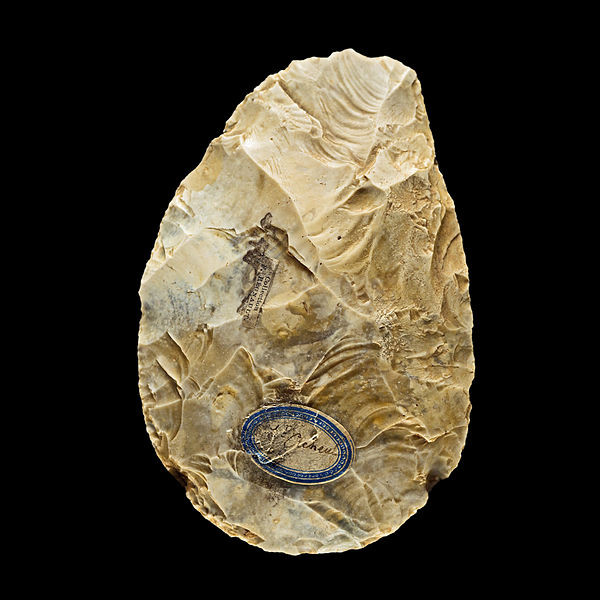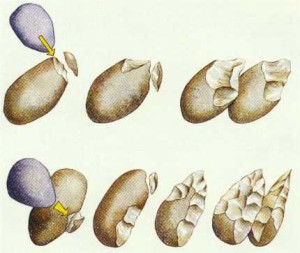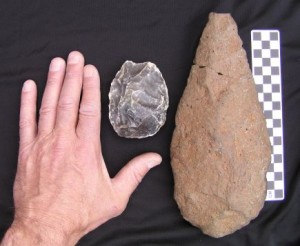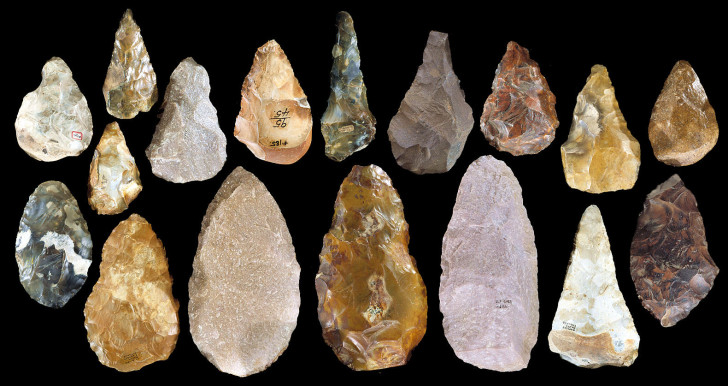In the beginning, there was design.
Before any other human discipline, even before the dawn of mankind its self, design was a practice passed down from generation to generation of early humans. Today, everything that has been designed–space ships, buildings, pyramids, weapons, clothing , artwork, everything–can be traced back to a single designed object. The first designed object: the Acheulean hand axe.
The Acheulean hand axe does not look like an “axe.” There’s no handle, and no metal. It could be called the “Acheulean pointy hand rock,” because it is just a rock that has been chipped and shaped, usually into the form of a tear-drop.


The term “Acheulean” refers to where the first specimens were found, on a dig site in Saint-Acheul, France. Other hand axes have been dug up in Africa, Europe and South Asia.
Early humans created these hand axes by breaking off big pieces with large rocks, and then shaping the fine edge with smaller rocks and pieces of bone. Making one of these things requires effort, skill, and time — anywhere from fifteen minutes to several hours.
Acheulean hand axes were the first products of a design process, but they were not the first tools ever made.
The first tools were basically just rocks, or rocks that were chipped with a few major strikes to produce a few sharp edges. Anthropologists call these “Oldowan tools,” which our Homo habilis ancestors would simply go out and select, rather than design.

Selecting Oldowan tools requires cunning, but not craft. When early humans realized that they could fashion more precise tools by sharpening rocks purposefully, the hand axe became the first tool made with an end goal in mind.
An end goal which we today do not know.

Even after finding so many of them, we don’t know how the Acheulean hand axe was used. It’s a mystery. There are a number of ideas and explanations as to why the hand axe appeared. Among them:
Theory #1: The “Swiss Army Knife” theory
The hand axe could have been a multi-tool, primarily used for butchering meat, and also good for breaking open nuts or grubs.
- Strength of the argument: these uses fit with the wear patterns on the hand axes that have been found.
- Weakness of the argument: in some cases, the full perimeter of the axe is sharp. This means that if you wanted to hold it, there’d be a sharp blade digging into your palm. Another problem with this theory is that some of the axes are symmetrical, which requires more effort than necessary if you’re just using it to breaking up nuts or cut meat.
Theory #2: The “Sexy Hand Axe” theory
The hand axe didn’t have a “use” per se, and was created mostly a way of showing off for mate attraction.
- Strength of the argument: Making these things is really really hard. Why spend so much time doing it unless you’re showing off? You’re showing the opposite sex what you can do.
- Weakness of the argument: Not all hand axes are nice and neat and symmetrical. There’s a lot of variation, and a lot depends on what rock they’re made of, and how precisely the sides have been sharpened. They weren’t all pretty.
Theory #3: The “Killer Frisbee” theory
Hand axes were made to be projectiles, thrown in the fashion of the discus in the olympics.
- Strength of the argument: Perhaps hunters would bombard animals with hand axes. This might not be enough to make a kill, but the stones could maim a few and give a hunters an advantage. This hypothesis explains why they’re sharp all the way around, symmetrical, and aerodynamic.
- Weakness of the argument: Again, not all hand axes sharp all the way around and perfectly symmetrical. These things were made on three different continents over the course of a million years. There’s variation.

No matter what Ascheulean technology actually was used for, it must been effective, because this basic design was used for an incomprehensibly long time. Hominid adults were literally teaching hominid children how to make hand axes for over a million years.
Before there was mathematics, engineering, science, art, music, poetry, philosophy, literature, religion, or even language, there was design. There was the Acheulean hand axe.




Comments (14)
Share
Early hominids were a lot smarter than we give them credit for. How about wrapping a piece of thick animal hide around the axe to hang on to it? A glove? what a novel idea. Maybe even tie or wrap it onto a lever? I suggest you think a bit more intelligently.
RH Grass Valley, California
I would guess that “shelter” was designed before any tool.
I found one of these in the California Sierra Nevada pass in a river bed.
The beginning and the “Sexy Hand Axe” part made me laugh so hard. :D Thanks for the episode!
You said you have TWO goto books on design?
I am also wondering what the other book is.
You wrote… “Even after finding so many of them, we don’t know how the Acheulean hand axe was used. It’s a mystery. There are a number of ideas and explanations as to why the hand axe appeared.”
My response: The mother of invention created these. Imagine your tribe being attacked by a superior force for your dried meat and food stores or for your women. Do you think that these early tools would just be laying around today if they weren’t comparable to a prehistoric sidearm used for either defense or offense? Once one tribe starts carrying knotted branches with these buggers embedded in them, then everyone would want one.
This brought back memories. I worked with replicas of Acheulean hand-axes in a wind tunnel for my senior project in engineering school back in 1995 (for the third, discus hunting weapon theory). I actually got to touch an actual hand-axe one day. I rubbed the surface with my finger to get a feel for the surface roughness, which earned a horrified look on the anthropologist’s face. Whoops.
Maybe they weren’t HAND axes at all. Maybe hurled with a leather sling?
It seems strange that if something was in use for a million years, it could only have one use. Isn’t it logical that all three theories, plus a thousand others, were all true at some point?
Listening to this podcast, could you add the actual swiss army knife to your list of possible podcast ideas?
Roman, Roman, Roman!
I am a longtime listener and have followed the dynamic emergent design of 99 percent invisible.
Unabashed fan.
BUT…..
this last episode Genesis Object…..
Something about the presentation was patronizing, the whole “Sexy Hand Axe”, etc.
A kind of “those wacky primitives!”
The stone axe is a tool that changed human development and culture.
It was THE definitive tool, and the craftspeople that made them were as gifted as any top jet propulsion designer.
If you look at stone axes in the National Museum in Copenhagen, you’ll notice something interesting.
When the Stone Age eventually transitioned into the Bronze Age, it wasn’t sudden.
It was a slow transformation.
The Bronze Age brought casting to weapon/tool making.
But in the beginning, it was mostly done south of the Nordic countries.
So traders traveling back and forth would bring up metal tools.
The master stone axe makers started COPYING the bronze tools in flint!!
Down to the casting lines!
Another thing- anthropologists and archaeologists are great at theories.
Don’t look to them for good tool making examples though, the best tool makers are craftspeople.
(Apologies to graduate students)
And craftspeople, the ones who make tools, are intuitive about the use of older tools.
A scientist can guess, the craftsperson has a much better idea of how to use something.
Those stone axes from thousands of years ago- no one has been able to reproduce those exactly.
They are masterpieces.
If you look at one of them, measure them digitally, they are so perfectly balanced its mind blowing.
The whole “Sexy Handaxe” thing- of course there were symbolic tools.
In the Nordic countries they would sacrifice tools. In those days (before the Viking gods came around, living up in the sky), the religion was fertility based, so the conduit to the other world was through the ground.
So tools and people were sacrificed in the bogs.
We don’t know why or what it meant. We often assume its to accompany or appease.
But anyway!
I wanted to convey the serious design qualities of the hand-axe.
No need to dress it up to make it cool.
I continue to be one of the 99 Percent Invisible faithful.
Great episode! I first heard about this from Bill Bryson’s “Brief History of Everything” and was glad to hear you were doing an episode on it. The point that stood out for me in his book was he same as for your podcast: That they did this for a *million* years. What a span!
But what jumped out while listening to your podcast today was that *today* we find them near riverbanks, and how that’s factoring into the theories of their use. But…rivers change course. In a million years, even geology & continent positions change a bit. The rivers we find them in today probably didn’t exist then. So maybe they are widespread but where a river run, they are exposed.
I realize this isn’t a paleontology website so my musings are going to end here. But thanks for the great show and a topic worth musing.
The first tool was a stick. Various sizes for various tasks. Hunting. Itching backs and ear canals. Sticks being hand shaped by breaking and peeling splinters. Doesn’t make the hand axe less badass. It was obviously a multitool and not a projectile haha!! Who throws their coveted hand axe when an abundance of spears and stones work better.
“Back in my day, all we had growin up was a hand axe. And my pappy. And his pappy. And his pappy. And his pappy. And his pappy. And his pappy…”